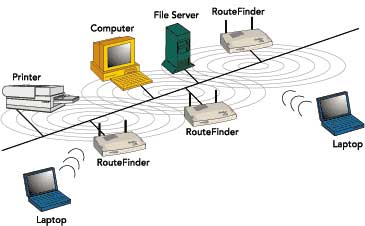
Simulation of an 802.11 Wireless Network
_________________________________________
Home Report Presentation Simulation Useful Links

Introduction
What are Wireless Local Area Networks (WLANs), and more importantly, how do they work? Before delving into the mundane technical jargon that is usually associated with wireless networks we are going to provide you with a simplistic definition. WLANs are Local Area Networks (LANs) that do not use traditional cable or wired systems. Instead they use Radio Frequency and Infrared (IR) to connect computers and peripherals over a network.
This project is part of an independent study and will simulate an 802.11 wireless network using MATLAB. The implementation simulates the Carrier Sense Multiple Access (CSMA) protocol with Collision Avoidance.
Further details on the protocol and our simulator have been included in our report and the presentation. These are available to be downloaded from this website through the links labeled "Report" and "Presentation" respectively.
Key Terms
1) RTS: When a node has a data packet to transmit, it first broadcasts a small packet called a Request-To-Send (RTS) packet.
2) CTS: When the intended recipient on the WLAN receives an RTS packet it broadcasts a small Clear-To-Send (CTS) packet.
3) ACK: Acknowledgement packet sent from the receiver to the sender upon successful completion of the data exchange.
4) CSMA/CA: Carrier Sense Multiple Access with Collision Avoidance (CSMA/CA) is a protocol in which (a) a carrier sensing scheme is used, (b) a data station that intends to transmit sends a jam signal, (c) after waiting a sufficient time for all stations to receive the jam signal, the data station transmits a frame, and (d) while transmitting, if the data station detects a jam signal from another station, it stops transmitting for a random time and tries again.
Project Goal
As mentioned above, the goal is to develop code that will simulate an 802.11 wireless network using CSMA/CA as the MAC protocol. From this simulation we will be able to provide an analysis of the following:
· Display of RTS/CTS packets
· Number of collisions with and without RTS/CTS, deaf node
· Number of mobile communication stations
· Transmission range of each station
· Mobility of stations
· Average transmission time
In order to simplify our task certain assumptions about our network environment will be made. Our assumptions are as follows:
· Distributed Control Function is in use
· Propagation delay is assumed to be zero
Student Profiles
Pavan Pant
Graduate student at Boston University with an expected concentration in Computer Networks.
email: ppant@bu.edu
Thomas Castelli
Graduate Student at Boston University with an expected concentration in Computer Networks.
email:tjc1@bu.edu